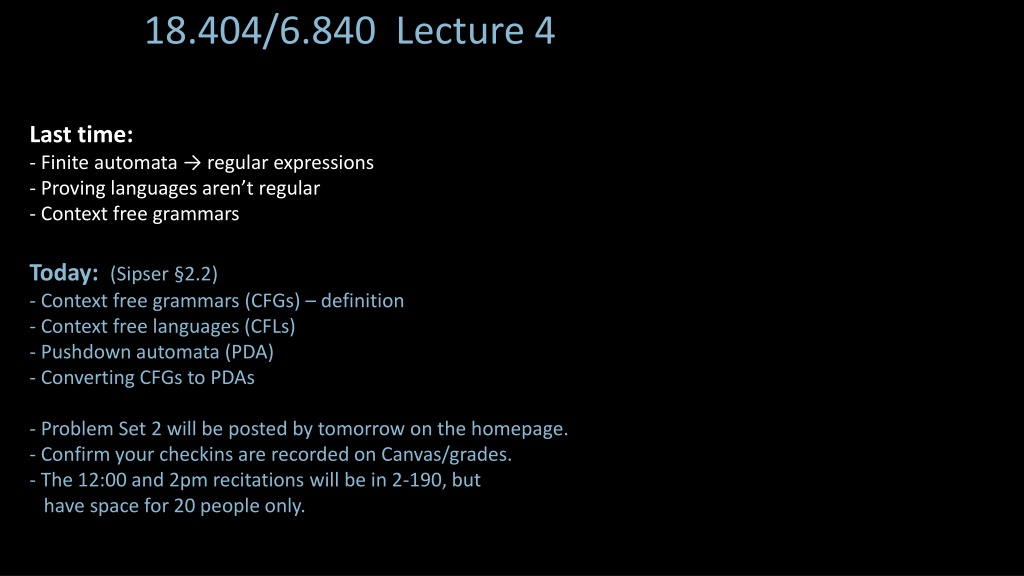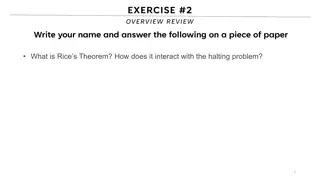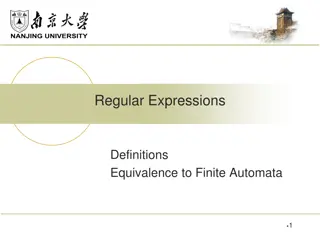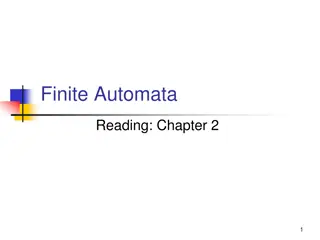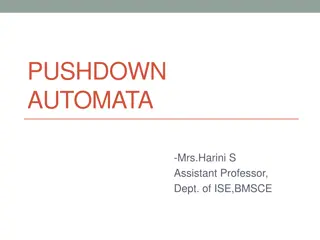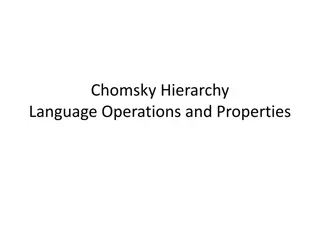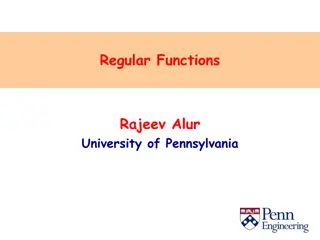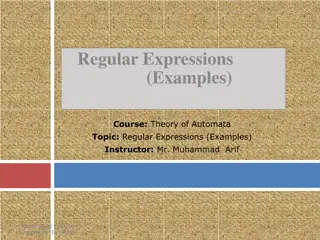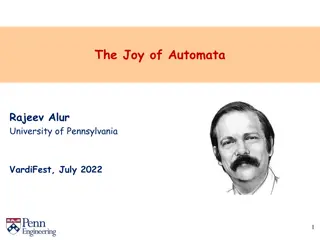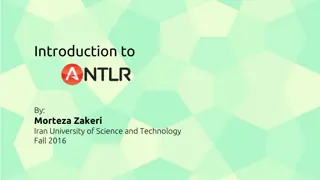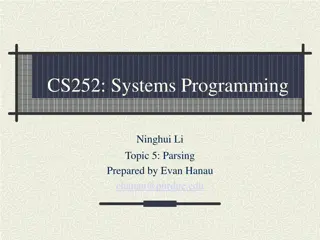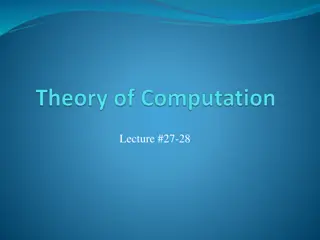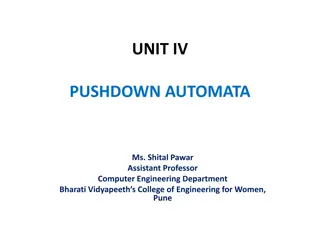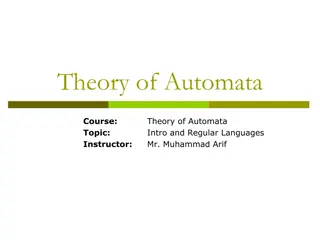Understanding Context-Free Grammars (CFGs) and Pushdown Automata
Exploring Context-Free Grammars (CFGs) and Pushdown Automata, covering definitions, examples, ambiguity, and conversions. Learn about generating strings, CFG formal definitions, ambiguity in grammars, and more. Connect with the basics of context-free languages and their relations to PDAs. Dive into the world of language theory and computational complexity.
Download Presentation

Please find below an Image/Link to download the presentation.
The content on the website is provided AS IS for your information and personal use only. It may not be sold, licensed, or shared on other websites without obtaining consent from the author. Download presentation by click this link. If you encounter any issues during the download, it is possible that the publisher has removed the file from their server.
E N D
Presentation Transcript
18.404/6.840 Lecture 4 Last time: - Finite automata regular expressions - Proving languages aren t regular - Context free grammars Today: (Sipser 2.2) - Context free grammars (CFGs) definition - Context free languages (CFLs) - Pushdown automata (PDA) - Converting CFGs to PDAs - Problem Set 2 will be posted by tomorrow on the homepage. - Confirm your checkins are recorded on Canvas/grades. - The 12:00 and 2pm recitations will be in 2-190, but have space for 20 people only.
Context Free Grammars (CFGs) ?1 Shorthand: S 0S1 S R R S 0S1 | R R Recall that a CFG has terminals, variables, and rules. Example of ?1 generating a string Grammars generate strings 1. Write down start variable 2. Replace any variable according to a rule Repeat until only terminals remain 3. Result is the generated string 4. ?(?) is the language of all generated strings 5. We call ?(?) a Context Free Language. Tree of S S Resulting string substitutions parse tree 0 S 1 0S1 0 S 1 00S11 R 00R11 ? ?1 0011 ? ?1 = 0?1? ? 0}
CFG Formal Definition Defn: Defn: A Context Free Grammar (CFG) ? is a 4-tuple (?, ,?,?) ? finite set of variables finite set of terminal symbols ? finite set of rules (rule form: ? ? ) ? start variable For ?,? ? write 1) ? ? if can go from ? to ? with one substitution step in ? 2) ? ? if can go from ? to ? with some number of substitution steps in ? ? ?1 ?2 ??= ? is called a derivation of ? from ?. If ? = ? then it is a derivation of ?. Check-in 4.1 Which of these are valid CFGs? ?1: B 0B1 | B1 1B 0B 0B ?2: S 0S | S1 R RR a) ?1 only b) ?2 only c) Both ?1 and ?2 d) Neither ? ? = ? ? and ? ?} Defn: ? is a Context Free Language (CFL) if ? = ?(?) for some CFG ?. Check-in 4.1
CFG Example ?2 Resulting string E Parse tree E E E+T | T T T F | F F ( E ) | a E + T E+T T T F T+T F F F a F+F a ? = {E, T, F} = {+, , (, ), a} ? = the 6 rules above ? = E ? ?2 aaa a+a a Check-in 4.2 How many reasonable distinct meanings does the following English sentence have? The boy saw the girl with the mirror. (a) 1 (b) 2 (c) 3 or more Generates a+a a, (a+a) a, a, a+a+a, etc. Observe that the parse tree contains additional information, such as the precedence of over + . If a string has two different parse trees then it is derived ambiguously and we say that the grammar is ambiguous. Check-in 4.2
Ambiguity ?3 ?2 E E+E | E E | ( E ) | a E E+T | T T T F | F F ( E ) | a E E E Both ?2 and ?3 recognize the same language, i.e., ? ?2 = ? ?3. However ?2 is an unambiguous CFG and ?3 is ambiguous. E E a + a a E E E E E
Pushdown Automata (PDA) head a b a b a a Finite control input appears on a tape c d d Schematic diagram for DFA or NFA (pushdown) stack Schematic diagram for PDA Operates like an NFA except can write-add or read-remove symbols from the top of stack. pop push Example: PDA for ? = 0?1? ? 0 1) 2) 3) Read 0s from input, push onto stack until read 1. Read 1s from input, while popping 0s from stack. Enter accept state if stack is empty. (note: acceptance only at end of input)
PDA Formal Definition Defn: Defn: A Pushdown Automaton (PDA) is a 6-tuple (?, , ,?,?0,?) input alphabet stack alphabet ?: Q ? ? ?(? ?) ? ?,a,c = ?1,d , ?2,e at the end of the input string. Accept if some thread is in the accept state Example: PDA for ? = {?? |? 0,1 } 1) Read and push input symbols. Nondeterministically either repeat or go to (2). 2) Read input symbols and pop stack symbols, compare. If ever then thread rejects. 3) Enter accept state if stack is empty. (do in software ) Sample input: 0 1 1 1 1 0 The nondeterministic forks replicate the stack. This language requires nondeterminism. Our PDA model is nondeterministic.
Converting CFGs to PDAs Theorem: If ? is a CFL then some PDA recognizes ? Proof: Convert ? s CFG to a PDA E E+T | T T F PDA CFG E E+T | T T T F | F F ( E ) | a ?2 IDEA: PDA begins with starting variable and guesses substitutions. It keeps intermediate generated strings on stack. When done, compare with input. E E + T T T + T F T + a + a a Input: E E E + T E+T T T F T+T F Problem! Access below the top of stack is cheating! Instead, only substitute variables when on the top of stack. If a terminal is on the top of stack, pop it and compare with input. Reject if . F F a F+F a aaa a+a a
Converting CFGs to PDAs (contd) E E+T | T T T F | F F ( E ) | a ?2 Theorem: If ? is a CFL then some PDA recognizes ? Proof construction: Convert the CFG for ? to the following PDA. 1) Push the start symbol on the stack. 2) If the top of stack is Variable: replace with right hand side of rule (nondet choice). Terminal: pop it and match with next input symbol. 3) If the stack is empty, accept. E E E + T E+T a + a a T T F Example: T+T F F F a F+F a T + T a + T T + T E + T F + T E T F aaa a+a a
Equivalence of CFGs and PDAs Theorem: ? is a CFL iff* some PDA recognizes ? Done. In book. You are responsible for knowing it is true, but not for knowing the proof. * iff = if an only if means the implication goes both ways. So we need to prove both directions: forward ( ) and reverse ( ). Check-in 4.3 Is every Regular Language also a Context Free Language? (a) Yes (b) No (c) Not sure Check-in 4.3
Recap Recognizer Generator Regular language Regular expression DFA or NFA Context Free language Context Free Grammar PDA Context Free languages Regular languages
Quick review of today 1. 1. Defined Context Free Grammars (CFGs) Defined Context Free Grammars (CFGs) and Context Free Languages (CFLs) and Context Free Languages (CFLs) 2. 2. Defined Pushdown Automata(PDAs) Defined Pushdown Automata(PDAs) 3. 3. Gave conversion of CFGs to PDAs. Gave conversion of CFGs to PDAs.
